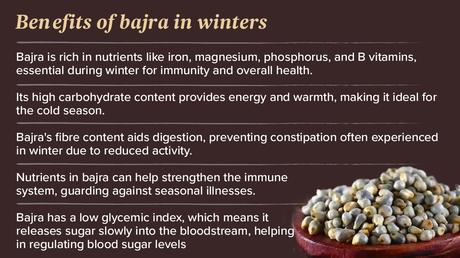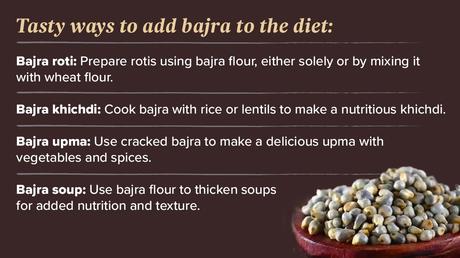Millets, the age-old grains, are back on the agenda after decades of being forgotten, thanks to their amazing nutritional profile that may also keep many chronic diseases at bay. In modern times, as consumption of unhealthy foods high in carbohydrates, sugar and fat increases, people struggle to include good quality protein, fiber and other essential micronutrients in their diet. Millet changed from a staple food to a redundant grain over the years, as production declined and food preferences shifted to wheat, rice and a Western diet. While we prioritized taste buds over nourishing our bodies, millets, which are rich in iron, protein, fiber, vitamins, magnesium and basically all the superior nutrients, were ignored. One such forgotten grain is pearl millet, also known as Bajra, one of the oldest millets that is not only affordable and nutritious but also eco-friendly and drought-resistant. (Also Read | Ancient Wisdom Part 28: Why Jaggery is the Perfect Winter Superfood; Best Ways to Consume It)

Pearl millet, grown in tropical, semi-arid regions of Asia and Africa, is rightly promoted as a food for poor people because of their affordability and high productivity. Bajra, like many other millets, is gluten-friendly and can be easily consumed by people with celiac disease. Diets rich in plant foods provide protection against cancer, cardiovascular disease, diabetes, metabolic syndrome and Parkinson's disease. With high iron and zinc content, bajra can help with anemia. The American Diabetes Association has found lower diabetes incidence in millet-consuming populations, which is yet another reason for you to embrace this crop. Studies have also shown how pearl millet can prevent cancer and also help with bone repair and development. Pearl millets are also the ultimate superfood for your gut health, as they not only relieve constipation with their high fiber content, but can also help treat diarrhea due to the presence of lactic acid bacteria, which act as a probiotic.
Also read
2023 has been declared the International Year of Millet on behalf of the Indian government and India recently organized a five-day millet festival in Indonesia to popularize the grain and create a market for it.
"Pearl Millet (Pennisetumglaucum), also known as Bajra, is one of the oldest millets used by our ancestors and is one of the most important grains grown in tropical, semi-arid areas of the world, mainly in Asia and Africa .Bajra is a very cheap millet, known as "poor people's food". It has immense health benefits and is recommended to patients with celiac disease, constipation and various non-communicable diseases. In India it is used as a regular meal in states like Rajasthan and Gujarat. Due to its potential health benefits, it has now gained popularity, nutritionists and dieticians recommend it for its better health options," says Ruhi Khan, dietician at Bhatia Hospital in Mumbai.

Benefits of bajra during winter
As the winter season approaches, Bajra can be added to the diet in various ways, be it roti, soup, porridge, smoothie to name a few. The consumption of Bajra dates back to 3,500-2,000 BC, as evidence of its consumption has been found on the Korean Peninsula. Bajra is also mentioned in ancient Indian texts such as Yajurveda and also in medicinal texts such as Nali. It is described in Ayurveda as Kutsitadhanya or unpalatable, but its gluten-free properties and nutritional profile are appreciated in ancient texts.
'In ancient times, bajra was consumed both as flour and grain. It was the staple diet of a large majority of Indians.
Traditionally, kambu sadam or bajra rice was consumed in every home in Tamil Nadu with raw onions and green chillies. It was also consumed in the form of halwa, khichdi and dosas, by combining it with other grain flours. Bajra can be made into the form of khichdi, pancakes, raab, roti, dosa, chilla, pizza, bajra puri, soup, kheer, laddoo, upma, muthias, halwa etc," says Khan.
Here are some benefits of Bajra in winter season as explained by Khan.
1. Minerals such as iron, phosphorus, potassium and magnesium, which are useful for the overall health and well-being of an individual, are found in abundant amounts in bajra.
2. Bajra is high in dietary fiber which improves digestion and helps prevent constipation. Additionally, fiber promotes a feeling of fullness, which has a benefit in weight management.
3. Since Bajra is a naturally gluten-free grain, it is useful for people with celiac disease, gluten sensitivity or intestinal-related diseases.
4. Bajra is a complex carbohydrate and helps in boosting energy. It is an ideal source of long-lasting energy in winter, because they release energy gradually.
5. The vitamins and minerals in bajra support the overall functioning of the immune system and help the body's defense against diseases that are more common in winter.
6. Consuming bajra in winter helps increase lung strength as the anti-inflammatory properties of this versatile grain can ease breathing.
7. Moreover, bajra has a lower glycemic index. It absorbs slowly and prevents sugar spikes. So it is an ideal grain for diabetics.
Also read
Amreen Shaikh, Head Dietitian, Wockhardt Hospitals, Mumbai Central, adds to the list of benefits.
- Nutrient-rich: Bajra is rich in nutrients like iron, magnesium, phosphorus and B vitamins, which are essential for immunity and overall health in winter.
- Heat provider: The high carbohydrate content provides energy and warmth, making it ideal for the cold season.
- Digestive health: The fiber content of Bajra aids digestion and prevents constipation that often occurs in winter due to reduced activity.
- Immunity booster: Nutrients in bajra can help strengthen the immune system and protect against seasonal diseases.
- Regulates blood sugar levels: Bajra has a low glycemic index, which means it releases sugar slowly into the bloodstream, which helps regulate blood sugar levels, an important factor in winters.
READ ALSO
How Bajra was consumed in ancient times
Shaikh explains how the ancient grains were consumed in ancient times.
In ancient times, Bajra was consumed in various ways:
- Bajra roti: One of the most common ways was to make rotis (flatbreads) with bajra flour.
- Dad: It was also used to make porridge, which was a staple of many ancient diets.
- Brewed drinks: Bajra grains were brewed to make drinks.

Tasty ways to add bajra to the diet:
- Bajra roti: Prepare rotis using bajra flour, alone or by mixing it with wheat flour.
- Bajra Khichdi: Cook bajra with rice or lentils to make a nutritious khichdi.
- Bajra upma: Use cracked bajra to make a delicious upma with vegetables and spices.
- Bajra soup: Use bajra flour to thicken soups for extra nutrition and texture.
READ ALSO
Who cannot consume Bajra?
"Bajra, like many millets, contains goitrogenic substances such as glucosylvitexin and glycosylorientin. Excessive consumption of bajra may disrupt thyroid function by interfering with iodine absorption. Individuals at risk of hypo- or hyperthyroidism, as well as those currently dealing with thyroid disorders, should seek advice from a registered medical professional before including bajra in their diet," says Khan.
Shaikh says that while bajra is generally nutritious, people with certain conditions should be careful:
- Kidney stones: Bajra is rich in oxalates, which can contribute to the formation of kidney stones. People prone to kidney stones may need to moderate their intake.
- Allergies or digestive problems: Some individuals may have allergies or digestive problems related to bajra. In such cases it is wise to avoid this.
